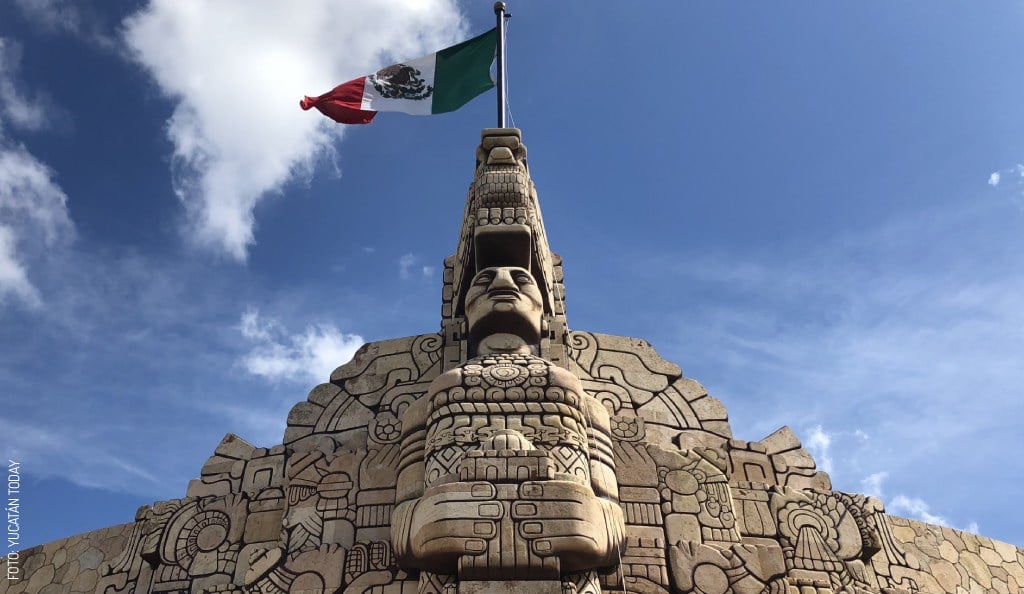
Monumento a la Patria, a Mérida Icon
 We couldn’t talk about Mérida without devoting a space to one of its most impressive sights: the Monumento a la Patria (monument to our homeland), which today marks where Paseo de Montejo ends and its extension (Prolongación) begins. Entirely hand-carved in local quarry stone, it’s no surprise that this, well, monumental sculpture is one of the city’s (and even the state’s) most visited sites. Here we’ll be telling you about some of its most remarkable elements, to help you better appreciate it and understand what it means to both Yucatecos and Mexicans.
We couldn’t talk about Mérida without devoting a space to one of its most impressive sights: the Monumento a la Patria (monument to our homeland), which today marks where Paseo de Montejo ends and its extension (Prolongación) begins. Entirely hand-carved in local quarry stone, it’s no surprise that this, well, monumental sculpture is one of the city’s (and even the state’s) most visited sites. Here we’ll be telling you about some of its most remarkable elements, to help you better appreciate it and understand what it means to both Yucatecos and Mexicans.
Its execution took Colombian sculptor Rómulo Rozo 11 years. Its massive size (14 meters high and 40 meters in diameter, or 46 and 131 if feet are easier to picture) comprises over 300 figures representing not only México’s history, but also symbols that make up both Mexican and Yucatecan culture. Its most distinctive feature is the figure of an indigenous woman, richly adorned with bracelets, earrings and a necklace that includes a seashell, evoking the Itzá clan’s marine background.
At her feet, beneath the Mérida city crest, you’ll see a representation of a traditional Maya house; inside “burns” the hearth, which also represents Mexicans’ love for our homeland. On either side, as if protecting it, there are two jaguar warriors, which represent not only the fierceness of México’s pre-Hispanic peoples, but also the devotion of its armed forces to this day.
 Behind the woman, on the north side, you’ll see two of México’s most recognizable symbols: just off-center, the representation of the golden eagle standing on a cactus devouring a snake; behind it, a Ceiba, the sacred tree of the Maya, with branches extending up to heaven and roots that reach the underworld.
Behind the woman, on the north side, you’ll see two of México’s most recognizable symbols: just off-center, the representation of the golden eagle standing on a cactus devouring a snake; behind it, a Ceiba, the sacred tree of the Maya, with branches extending up to heaven and roots that reach the underworld.
However, it may be the walls that make up the semicircle that make it practically unique: many of our nation’s most important historical figures are depicted along its roughly fifty meters’ length. Depending on your worldview, you might see them pictured as if they’re ready to march, or posing for a very crowded group photo; some of them are carrying “banners” commemorating the milestones they were a part of. There aren’t many monuments in México that capture as many national heroes; much less paying homage to the pages of history written before México was called México, let alone New Spain.
Rómulo Rozo, they say, aimed to create a sculpture where love for México and Yucatán could come together in one piece. To this day, we could say that the Monumento a la Patria continues to capture more than one duality: indigenous and European, classical and contemporary, the past and the future.
The Monumento a la Patria is visited by both locals and tourists; it’s the site of both celebrations and protests, and a place where practically all Yucatecos find themselves at some point. From its inauguration in 1956 to this day, the Monument has witnessed Mérida’s evolution; we can only imagine what it has yet to see!

Author: Alicia Navarrete Alonso
As a kid I heard that there's more to see than can ever be seen and more to do than can ever be done, so I set out to try. I'm passionate about knowledge and I love to share whatever my own is.
¡Receive the latest articles and much more from the best of Yucatán in your email!
Related articles

The Many Styles of Maya Architecture
Maya architecture shares features that include the use of corbelled archways, monumental stairway, and richly decorated exteriors.
Rómulo Rozo, the artist behind Mérida’s Monumento a la Patria
Learn about the life of Rómulo Rozo, a historical figure of Yucatán, beloved parcero and singer-songwriter, and sculptor of the Monumento a la Patria.



.jpg)


